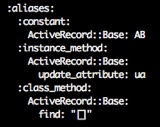 I attended the Rails Underground conference in London at the weekend (July 24-25, 2009). As always seems to be the case at these events, I got the most value out of the more theoretical and opinion-based talks rather than ‘how-to’ style presentations. Having said that, Pat Allan and George Palmer gave great talks on their respective thinking_sphinx and couch_foo plugins.
I attended the Rails Underground conference in London at the weekend (July 24-25, 2009). As always seems to be the case at these events, I got the most value out of the more theoretical and opinion-based talks rather than ‘how-to’ style presentations. Having said that, Pat Allan and George Palmer gave great talks on their respective thinking_sphinx and couch_foo plugins.
I’m going to concentrate on the keynotes from the two days, which give quite differing perspectives.
Fred George – Rails is a hammer. Not everything is a nail.
 In the keynote (video link) for the first day, former Thoughtworker, Fred George warned us against using Rails for the wrong kinds of projects. Read More
In the keynote (video link) for the first day, former Thoughtworker, Fred George warned us against using Rails for the wrong kinds of projects. Read More







 In
In  Like
Like 
 Until recently, I had been using the
Until recently, I had been using the 
 A couple of weeks ago we featured
A couple of weeks ago we featured  With people occasionally talking about “Code vs. Data”, it only makes sense that you should be able process over code as you would a string.
With people occasionally talking about “Code vs. Data”, it only makes sense that you should be able process over code as you would a string.  Inspired by
Inspired by 
 When running a Ruby daemon which executes code in a loop, if the process is killed while something is happening then problems can occur if the code doesn’t handle all the exceptions properly or if the loop isn’t broken cleanly.
When running a Ruby daemon which executes code in a loop, if the process is killed while something is happening then problems can occur if the code doesn’t handle all the exceptions properly or if the loop isn’t broken cleanly. 


